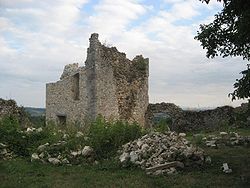
Nikola IV Zrinski or Miklós IV Zrínyi, also commonly known as Nikola Šubić Zrinski, was a Croatian nobleman and general, Ban of Croatia from 1542 until 1556, royal master of the treasury from 1557 until 1566, and a descendant of the Croatian noble families Zrinski and Kurjaković. During his lifetime the Zrinski family became the most powerful noble family in the Kingdom of Croatia.
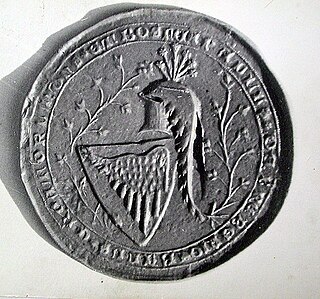
The Šubić family was one of the Twelve noble tribes of Croatia and a great noble house which constituted Croatian statehood in the Middle Ages. They held the county of Bribir (Varvaria) in inland Dalmatia. From them branched prominent Zrinski family.
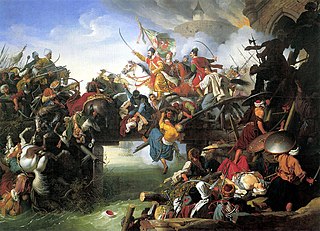
The siege of Szigetvár or the Battle of Szigeth was a siege of the fortress of Szigetvár, Kingdom of Hungary, that blocked Sultan Suleiman's line of advance towards Vienna in 1566. The battle was fought between the defending forces of the Habsburg monarchy under the leadership of Nikola IV Zrinski, former Ban of Croatia, and the invading Ottoman army under the nominal command of Sultan Suleiman the Magnificent.

Zrinski was a Croatian-Hungarian noble family, a cadet branch of the Croatian noble tribe of Šubić, influential during the period in history marked by the Ottoman wars in Europe in the Kingdom of Croatia's union with the Kingdom of Hungary and in the later Kingdom of Croatia as a part of the Habsburg monarchy. Notable members of this family were Bans of Croatia, considered national heroes in both Croatia and Hungary, and were particularly celebrated during the period of Romanticism, a movement which was called Zrinijada in Croatia.

Petar IV Zrinski was Ban of Croatia (Viceroy) from 1665 to 1670, general and a writer. A member of the Zrinski noble family, he was noted for his role in the attempted Croatian-Hungarian Magnate conspiracy to overthrow the Habsburgs, which ultimately led to his execution for high treason.

Novi Zrin was a fortress of the Zrinski noble family built near the Donja Dubrava village in the northernmost part of Croatia on the mouth of river Mura into Drava between 1661 and 1664.
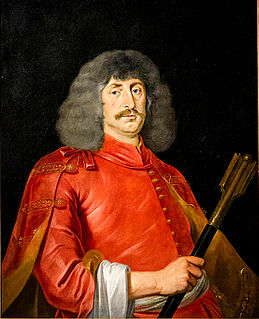
The Magnate conspiracy, also known as the Zrinski-Frankopan Conspiracy in Croatia, and Wesselényi conspiracy in Hungary, was a 17th-century attempt to throw off Habsburg and other foreign influences over Hungary and Croatia. The attempted coup was caused by the unpopular Peace of Vasvár, struck in 1664 between Holy Roman Emperor Leopold I and the Ottoman Empire. The poorly organized attempt at revolt gave the Habsburgs reason to clamp down on their opponents. It was named after Hungarian Count Ferenc Wesselényi, and by Croatian counts, brothers Nikola Zrinski and Petar Zrinski and Petar's brother-in-law Fran Krsto Frankopan.

Zrin is a village in Croatia, Sisak-Moslavina County.
This is the family tree of the Princes of Zrin, a Croatian noble family, from 1347 to 1703.
Paul II Šubić of Bribir was a Count of Trogir and Ostrovica and a member of the Croatian Šubić noble family.
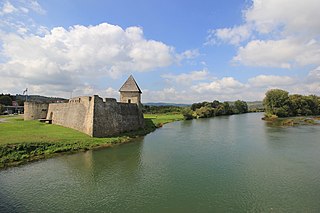
Kostajnica Fortress is a castle in Hrvatska Kostajnica, a town in central Croatia, near the border to Bosnia and Herzegovina.

Juraj IV Zrinski was a Croatian count, a member of the Zrinski noble family, and royal Master of the treasury from 1567 until his death in 1603.

Nikola III Zrinski was a Croatian nobleman, a member of the Zrinski noble family, influential in the Kingdom of Croatia.

Gvozdansko Castle is a castle in Gvozdansko village, between the towns of Dvor and Glina and not far from Zrin Castle, in Sisak-Moslavina County, central Croatia.

Nikola VII Zrinski was a Croatian and Hungarian military leader, statesman and poet. He was a member of the House of Zrinski, a Croatian-Hungarian noble family. He is the author of the first epic poem, The Peril of Sziget, in Hungarian literature.

The Austro-Turkish War (1663–1664) or fourth Austro-Turkish War was a short war between the Habsburg monarchy and the Ottoman Empire. The Ottoman aim was to resume the advance in central Europe, conquer Vienna and subdue Austria. The Ottomans managed to capture key strongholds, however, the Habsburg army under Raimondo Montecuccoli succeeded in halting the Ottoman army in the Battle of Saint Gotthard.
Zrin is a village in Sisak-Moslavina county, Croatia

The siege of Gvozdansko was an Ottoman siege of the fort of Gvozdansko in the Kingdom of Croatia in 1577–1578. In the 1570s, the Ottomans intensified their efforts to capture the valley of the Una River. A string of forts along the Una, centred around Gvozdansko and in possession of the Zrinski noble family, formed the main line of defense of Croatia since 1527. The fort held off Ottoman attacks in 1540 and 1561.

The siege of Novi Zrin ; Croatian: Utvrda Novi Zrin; Hungarian: Új-Zrínyivár; Turkish: Zerinvar) in June/July 1664 was last of the military conflicts between the Croatian forces led by Nikola Zrinski, Ban (viceroy) of Croatia, and the Ottoman army commanded by Köprülü Fazıl Ahmed Pasha, Grand Vizier, dealing with possession of Novi Zrin Castle, defended by Croats, situated on the bank and marshy islands of Mura River, near the border line between northern Croatia and southwestern part of Hungary, at the time occupied by the Ottomans. The battle resulted in destruction of the castle, and retreat of the Croatian crew, that was forced to withdraw to safer territory of inland Croatia.

Ostrovica Fortress is a ruined medieval fortification on a solid rock jutting from the top of the hill above the village of Ostrovica in Zadar County, Croatia. It is located between the two historical and geographical regions, Bukovica and Ravni Kotari. It was once an important stronghold, known as the "Key to the City of Zadar", as it was a key defense of the city. It was destroyed during the Ottoman–Venetian Wars in the second half of the 17th century, leaving only a few remains.
